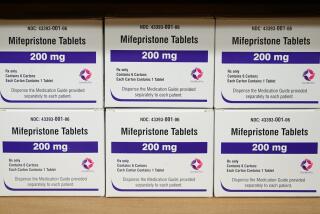The Pill Is the Pill Is the Pill
- Share via
In 1958, Aldous Huxley had this to say in “Brave New World Revisited”: “Most of us choose birth control--and immediately find ourselves confronted by a problem that is simultaneously a puzzle in physiology, pharmacology, sociology, psychology and even theology. ‘The Pill’ has not yet been invented.”
But less than four years later, shortly after the FDA had approved steroid oral contraceptives for general use, the word “Pill”--capitalized or not, but preceded by the article “the”--had acquired its Huxlean meaning and became so anointed in dictionaries.
To me, an organic chemist who contributed to the first synthesis of an oral contraceptive, “the Pill” means 17a-ethynyl-19-nortestosterone or norethindrone--the technical term for the chemical that is still the active ingredient of many currently used oral contraceptives and the chemical progenitor of all others that followed. But to nonchemists, Huxley’s “puzzle” Pill has been converted into the Pill--a solution to birth control that has affected the lives of women (and hence men) in ways that few other postwar scientific discoveries have done. For millions of couples in the First or the Third World--rich or poor, young or adult, married or unmarried--sexual intercourse and use of the Pill have become virtually synonymous, because the Pill has separated birth control and coitus in ways that condoms, diaphragms or similar methods never could.
And now the Food and Drug Administration has approved a “morning after” or “after the fact” or just simply “postcoital” pill. Will that change sexual conduct or represent another liberating agent for women?
To a chemist, there is nothing new chemically about such a pill. The active ingredient is the same steroid as in standard oral contraceptives that prevent ovulation, except that as a postcoital contraceptive, much higher doses are taken for a couple of days following unprotected intercourse. But to sexually active women, the new pill offers further options.
As an emergency contraceptive, it may well be a godsend to a woman who has forgotten to take her Pill or any other birth control agent. For a woman who may indulge rarely in sexual intercourse, it may even be an acceptable standard method of contraception. (To a sexually active person, having intercourse weekly or more frequently, the cumulative exposure to such high dosages of steroids would be counterproductive).
Such a hormonal approach to postcoital contraception has existed for nearly 30 years. Even without FDA approval, it was legal for physicians to prescribe high dosages of estrogens or of standard oral contraceptives for such emergency purposes. But pharmaceutical companies could not promote such applications until large-scale studies had been carried out and formal application for FDA approval had been sought. There was, in fact, little commercial incentive for companies to do so, and it has only been the gradually increasing sub-rosa use for emergency contraception that has finally led to FDA approval. As a result, the pros and cons of such emergency contraception now can be openly publicized without the potential threat of legal complications.
The appropriateness of the postcoital pill’s administration in coercive sex, especially rape, is beyond argument. Even in consensual but unprotected sex, the use of a postcoital pill will reduce the incidence of abortions, although such an approach may not be acceptable to those persons who consider the moment of fertilization synonymous with independent life. After all, the mechanism of action of such postcoital pills may involve postfertilization interference in the reproductive process even if it just prevents the implantation of the fertilized egg in the uterus. But it would be dangerous for couples to become negligent about using regular contraception just because they are now aware of a postcoital alternative.
The availability, potential use and short-term side effects of such postcoital birth control should be widely publicized and intelligently presented as part of sex education--not as an incentive for casual sex, but rather as a component of a sexual emergency kit. I would go further: Since only a few pills need to be used, I would offer such emergency packages over the counter without a physician’s prescription but with very detailed package inserts. At the very least, such packages should be available in confidence from high school nurses.
The market for such pills is small enough so as not to offer any particular economic incentives to pharmaceutical companies. Hence none would conduct serious research and development to look for a specific steroid that is especially suited to such postcoital administration. Ironically, RU-486--quite separately from its highly publicized abortifacient applications--has been studied extensively for postcoital purposes and probably is to be preferred over the FDA-approved administration of high dosages of conventional oral contraceptives. There is little doubt, however, that RU-486 has been demonized to such an extent in the U.S. that its introduction as an emergency contraceptive would be fought viciously. So let’s be thankful for this latest FDA action and consider it as an additional item on the shelves of the rather sparse contraceptive supermarket now in existence.






